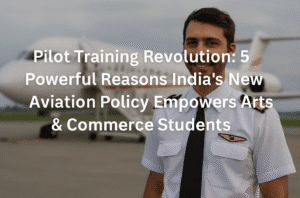Pilot Training Revolution: 5 Powerful Reasons India’s New Aviation Policy Empowers Arts & Commerce Students
In a landmark move, India’s aviation regulator, the DGCA, plans to scrap the mandatory requirement of physics and mathematics in Class 12 for aspiring commercial pilots, dismantling a 30-year-old rule that restricted the field to science students. This reform aims to democratize access to pilot training, allowing arts and commerce graduates to pursue a Commercial Pilot Licence (CPL) if medically fit, aligning India with global standards where such prerequisites don’t exist.
Aviation veterans, like Captain Shakti Lumba, argue the current criteria are outdated, as foundational concepts from junior classes—not senior-secondary physics—suffice for flight training. The shift addresses India’s pilot shortage amid booming airline growth, reduces reliance on expensive overseas training, and eliminates absurd inconsistencies (e.g., private pilot licenses lack similar academic hurdles). Simultaneously, the DGCA will rank flying schools on safety and efficiency to improve domestic training quality.
While critics may question competency, proponents stress that rigorous aviation-specific curricula—not irrelevant academic filters—ensure pilot proficiency. This inclusive policy prioritizes aptitude over stream, empowering diverse talent to fuel India’s aviation ambitions without compromising safety.

Pilot Training Revolution: 5 Powerful Reasons India’s New Aviation Policy Empowers Arts & Commerce Students
In a transformative move poised to reshape India’s aviation landscape, the Directorate General of Civil Aviation (DGCA) is set to dismantle a decades-old eligibility barrier for aspiring commercial pilots. Soon, Class 12 graduates from arts and commerce streams may no longer need physics and mathematics as compulsory subjects to pursue a Commercial Pilot Licence (CPL). This reform aims to democratize access to pilot training, align India with global standards, and address the surging demand for skilled pilots in the country’s rapidly expanding airline industry.
The Current Landscape: A Relic of the 1990s
Since the mid-1990s, India’s CPL eligibility criteria have restricted pilot training to science stream students with physics and maths in Class 12. This rule, now deemed “archaic” by aviation veterans, has long excluded talented candidates from non-science backgrounds. Before the 1990s, even a Class 10 pass could qualify individuals for flight training, reflecting a historical precedent for more inclusive access.
Captain Shakti Lumba, a veteran pilot with 31 years of experience, underscores the redundancy of the current requirement: “The physics and maths taught in Class 12 are irrelevant to piloting. The foundational concepts learned up to Class 10 are sufficient, as global standards suggest.” Countries like the U.S., U.K., and Australia do not mandate these subjects at the senior secondary level, relying instead on specialized aviation training to bridge knowledge gaps.
Why This Change Matters
Leveling the Playing Field
- Arts and commerce students passionate about aviation have historically faced an uphill battle, often resorting to re-taking Class 12 physics and maths via open schooling—a time-consuming and costly detour. Removing this barrier could empower a broader talent pool, fostering diversity in the cockpit.
Addressing Industry Demands
- India’s airline sector is booming, with orders for over 1,000 new aircraft placed in 2023 alone. However, a pilot shortage looms, exacerbated by the high cost of training abroad (where many students currently go due to inconsistent domestic flying school standards). By broadening eligibility, the DGCA aims to bolster domestic training capacity and retain talent within India.
Global Alignment
- The existing rule is a global outlier. For instance, India’s requirement for CPL—but not for a Private Pilot Licence (PPL)—has drawn criticism for its inconsistency. “Why should flying a private plane require less academic rigor than a commercial one?” questions a flying school operator, highlighting the paradox.
The Road Ahead: Reforms and Rankings
The DGCA’s overhaul doesn’t stop at eligibility. Plans to rank flying schools on safety, training quality, and CPL completion timelines aim to enhance transparency and accountability. This move responds to longstanding concerns about subpar infrastructure and delays in India, which drive students overseas.
Officials hint at additional reforms, including streamlined medical checks and updated training modules, to ensure candidates meet technical proficiencies without archaic academic hurdles.
Potential Concerns and Counterarguments
Critics may argue that diluting academic criteria could compromise competency. However, proponents emphasize that aviation-specific training—not Class 12 physics—equips pilots with necessary skills. CPL programs already cover aerodynamics, navigation, and meteorology, rendering senior secondary-level science redundant.
A Future of Inclusive Skies
This policy shift signals a recognition that passion and aptitude, not rigid academic tracks, should define career opportunities. For India’s youth, it unlocks a high-demand profession traditionally gatekept by stream choices. For the aviation sector, it promises a sustainable talent pipeline to fuel growth.
As Captain Lumba notes, “This isn’t about lowering standards—it’s about removing irrelevant ones.” With medical fitness and rigorous training still mandated, the skies remain safe, but the path to reaching them becomes just a little more equitable.
You must be logged in to post a comment.